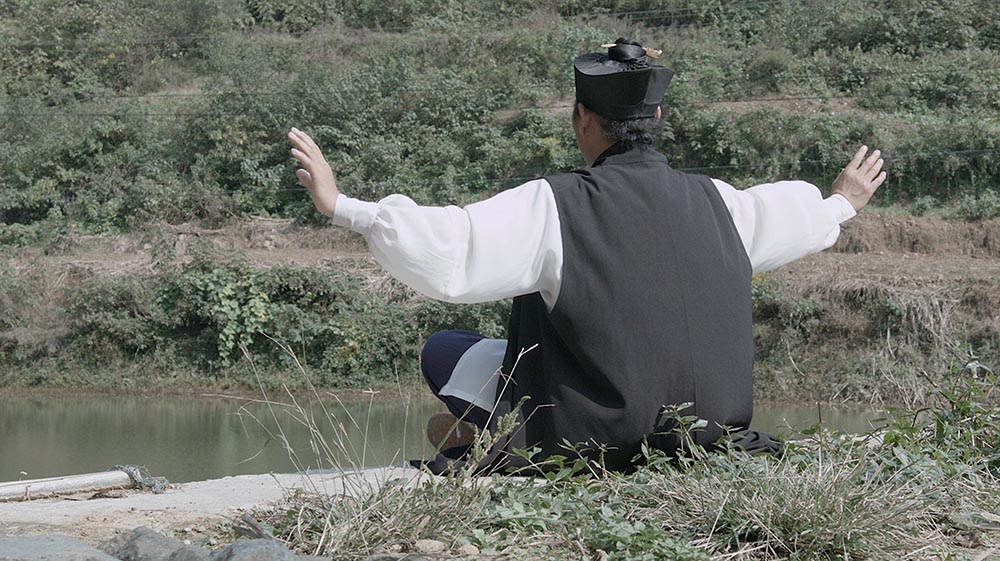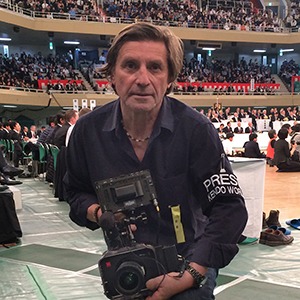Introduction to Dragongate School
There are dozens of martial art schools on Wudang Mountain practicing mainly Tai Chi Chuan and internal styles but only one school practices Wudang Dragongate kung fu. A few schools teach hard styles like Shaolin, but most teach the internal arts and Tai Chi Chuan. I was interested to visit the Wudang Dragongate school when I saw it was located in Plum Valley, a quiet retreat at the bottom of the mountain.
Dragongate school moved to Plum Valley when remaining on the mountain became too difficult due to new rules introduced to accommodate the influx of tourism. This new location afforded space for building modern rooms and dormitories that would attract new students, especially from outside China.

Director Jon Braeley traveling in Plum Valley, Wudang Mountain in a 3-wheel taxi

Young students performing outside the Dragongate school entrance
The Dragongate school, under the guidance of master Wang, teaches Wudang internal styles of Tai Chi, meditation (Nei Dan) and health preservation (Qigong). For some advanced students master Wang also offers classes in the internal styles of Bagua and Xingyi. New students are encouraged to stay as long as possible with comfortable private rooms and wifi. By moving into the valley Dragongate has been able to position itself as a holistic health retreat, offering quiet surroundings for meditation. There is a vegetable garden where students are encouraged to grow their own food and taste the Taoist way of living.
This is in sharp contrast to learning martial arts at Shaolin temple or Chen Village, where facilities can be basic and the lifestyle more harsh, especially to a foreign student. Wudang Mountain has taken a new approach in the last decade to attract ‘kungfu tourists’ and it appears to be working, as I have seen a sharp rise in the number of foreign students at the Wudang schools. In Wudangshan town, there is now a local government office of martial arts that governs the schools and ensures rules are met by school owners and teachers. This modern approach can be seen by the building of a modern 5,000 student size martial art university near the entrance to the mountain.
Dragongate kung fu school is featured in our award-winning movie, The Immortal Path: The Tao of Tai Chi Chuan.

Master Wang Xingqing in the school training grounds
Interview with Wang Xingqing
Can you tell me about this school?
Our school was founded in early 1999. we mainly teach kungfu of wudang Dragongate branch. Dragongate is created by Qiu chuji master and it has a history at Wudang Mountain for more than 700 years. There are many branches of kungfu in Wudang right now but Dragon gate is the main source. It is like the (main body) of a tree. Sanfeng, xuanwu, taiyi, all these are branches of dragon gate. We get up at 5 a.m. and practice till 6 a.m. and have breakfast at 6:30am. Then we rest till after 8 am and practice till 11 am. In the afternoon we practice from 3 to 5:30 or 6. In the evening, from 8 to 9 pm
There are many kungfu styles in dragongate branch, it includes not only tai chi, health maintenance, but also xingyi, bagua, wudang dragon gate sword, many styles. it is very comprehensive and it is a system. Since March 1999, it is already 15 years. the students are from more than 70 countries and regions and I have been to more than 10 countries.
There are two religions at Wudang Mountain, one is zhenyi, the other is quanzhen, Dragongate. But Dragongate is different with other branches as its system is very complete and inclusive. It is more similar than different with other branches at wudang, but the theoretical knowledge is somewhat different.
Can you explain the difference?
It includes many circling movements. The difference is that it includes both internal and external practice. Internal practice includes essence, qi and spirit, external practice is to practice muscles, bones, and skin. Morning and evening are very important in practicing sitting meditation in Dragongate branch. the other branches focus more on external gesture, while we focus on internal practice.
We practice physical and spiritual life together. Dan (lit. alchemy, elixir) practice includes internal dan and external dan. External dan uses herbs while internal dan uses qi, which is collected gradually and fills the part of dantian. To hold dantian until it becomes dan. When the physical body gets sick and qi from dantian can help to dissolve that and let the body recover by itself.

Some foreign students like the school’s location in Plum Valley, close to Wudangshan
Many Wudang masters have been to Shaolin Temple. Did you practice shaolin Kungfu before?
Yes. I learnt for one year in Shaolin at the age of 17. I practiced Da Hong Quan, Xiao Hong Quan and Jin Gang Quan. However, Wudang Mountain is my hometown. I am the only local person that opens kungfu school here at Wudang. My family has bee living here for generations. My first master is called Jia Hexuan, a Wudang taoist. He moved here from Jun Zhou and lived as my neighbor. I practiced with him since I was seven.
What is the difference between Shaolin and Wudang?
There is a big difference. Shaolin kungfu is mainly fast and focuses more on fighting and combating. The fists they practice are more hard, ours are more soft and flexible and slow. Taoism kungfu is different as fast kungfu is more hurtful for the body while slow kungfu is good for the body.
Each style as its attacking and defending kungfu, not just Wudang. The attacking kungfu of wudang is different with that of shaolin as external kungfu is more explosive and powerful. Our internal kungfu uses the power that the counterpart attacking us to attack back. it is its difference.

Can you talk more about dan or the alchemy practice?
The highest level is to practice physical and spiritual life together. Refining essence into qi, refining qi into spirit, refining spirit and reverting to emptiness and discovering the nature through emptiness. To discover the nature through emptiness is the last step. It is to combine together with the nature. The highest level os Taoism religion is to be immortal. What is immortal? To live forever.
We practice from the most basic level. To do sitting meditation and practice physical and spiritual life together. What is practicing physical and spiritual life together? Spiritual life is the base. It is the wisdom. We do good things in daily life. Physical life includes the essence, qi and spirit.

Each day Master Wang Xingqing practices qigong and meditation in the schools garden
So how do we know whether we get qi while practicing internal dan? First our dantian part feels warm and can have some feelings while we get sick. In fact, no matter what the climate is, cold or hot, we feel very comfortable and pleasant and can cure diseases by ourselves. After we have been practicing, the 12 channels of our body work smoothly and flowingly. The practitioner can move qi everywhere he wants in his body. In this situation, he can know when he has got qi. We talk about three dan (Dantian) —the lower dan, the middle dan and the upper dan. Dantian is lower than the naval, two and a half fingers lower
While doing sitting meditation and moving qi, we move qi from lower dan to middle dan, and then to upper dan. combining lower and upper dan together. the main channel in front of the body is Ren channel and the one behind is Du channel. They should be flowing smoothly. If not, the part that can block Ren is at the mouth area, and the part that can block Du is at the anal area. In practice, when the Ren is blocked, we lift the tip of the tongue and press it to the upper inside of the teeth. When the Du is blocked, we hold the anal. We adjust ourselves by breathing in and out and qi will be adjusted. While we have enough qi, we will have the spirit and dantian gets warm. This is a way to practice internal dan. This is quiet kungfu.
Read the full interview with Dragongate Kung Fu school in our book on Amazon, Masters of Tai Chi: The Interviews. Watch the trailer below for The Immortal Path, featuring Dragongate Kung Fu school.







